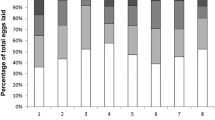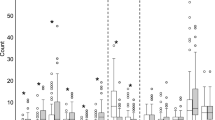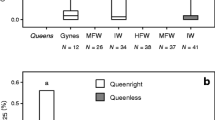Abstract
In most species of advanced eusocial insects, the partitioning of reproduction between nestmates is thought to be regulated by means of primer pheromones or other chemical cues, which presumably influence the behavior of co-queens and workers such that they maximize their own inclusive fitness. Here we show that in multi-queen colonies of the Nearctic ant, Leptothorax sp. A, physical dominance in concert with chemical cues, which signal the ovarian development of a queen, are used to control reproduction of competing queens and to influence worker behavior. The analysis of ranks obtained during two fighting periods in the annual colony cycle revealed a strong link between individual aggressiveness of a queen and her fertility. During the adoption of newly mated queens in autumn, the resident, egg-laying α-queen was more likely to start aggression first and keep her high rank position compared to the fighting period after hibernation. We suggest that this is proximately caused by the α-queen having much stronger developed ovaries in autumn than the young queens, whereas after hibernation, the ovaries of all queens are similarly inactive. Interactions during the first weeks after the end of hibernation and intrinsic, individual differences in aggressiveness appear to be crucial for the dominance rank achieved later. Queens which were allowed to become fertile when their nestmate queens still were kept under prolonged hibernation, were immediately socially dominant over the latter when all queens were reunited, though no aggression occurred. In another experiment, queen antagonism was prevented by spatial separation in different parts of the same nest and all queens began to lay eggs. Workers stayed preferentially with queens with high actual fecundity rather than with those which had had high social status before separation. This and further evidence suggest that ovarian status is communicated, most likely by a chemical cue perceived by co-queens and workers, affects the direction of their aggressive behavior, and allows them to discriminate among queens.
Similar content being viewed by others
Author information
Authors and Affiliations
Additional information
Received: 5 May 1998 / Accepted after revision: 29 August 1998
Rights and permissions
About this article
Cite this article
Ortius, D., Heinze, J. Fertility signaling in queens of a North American ant. Behav Ecol Sociobiol 45, 151–159 (1999). https://doi.org/10.1007/s002650050548
Issue Date:
DOI: https://doi.org/10.1007/s002650050548




